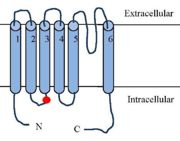Sandbox Reserved 1652
From Proteopedia
(Difference between revisions)
| Line 37: | Line 37: | ||
TRPV1 receptor has a '''capsaicin-binding pocket''' formed by S3,S4 and <scene name='86/868185/S4s5_linker/1'>S4-S5 linker</scene>. The capsaicin-binding pocket is surrounded by the residues <scene name='86/868185/Y511_s512_t550/2'>Y511,S512,T550</scene>.<ref>F. Yang et J. Zheng, « Understand spiciness: mechanism of TRPV1 channel activation by capsaicin », Protein Cell, vol. 8, no 3, p. 169‑177, mars 2017, doi: 10.1007/s13238-016-0353-7.</ref> | TRPV1 receptor has a '''capsaicin-binding pocket''' formed by S3,S4 and <scene name='86/868185/S4s5_linker/1'>S4-S5 linker</scene>. The capsaicin-binding pocket is surrounded by the residues <scene name='86/868185/Y511_s512_t550/2'>Y511,S512,T550</scene>.<ref>F. Yang et J. Zheng, « Understand spiciness: mechanism of TRPV1 channel activation by capsaicin », Protein Cell, vol. 8, no 3, p. 169‑177, mars 2017, doi: 10.1007/s13238-016-0353-7.</ref> | ||
| - | Bound capsaicin is oriented in a « tail-up, head down » configuration. In this configuration | + | Bound capsaicin is oriented in a « tail-up, head down » configuration. In this configuration,capsaicin is anchored into the receptor.<ref>F. Yang et al., « Structural mechanism underlying capsaicin binding and activation of the TRPV1 ion channel », Nat. Chem. Biol., vol. 11, no 7, Art. no 7, juill. 2015, doi: 10.1038/nchembio.1835.</ref> |
The capsaicin cycle binds via hydrogen bounds to amino acids on the S3 helix (<scene name='86/868185/Y511/1'>Y511</scene>), on the <scene name='86/868185/S4s5_linker/2'>S4-S5 linker</scene> and on the S6 helix (<scene name='86/868185/Tyr671/1'>T671</scene>). The amid group of capsaicin binds the <scene name='86/868185/S4/2'>S4</scene> helix.<ref name="Integrating TRPV1 Receptor Function with Capsaicin Psychophysics"> | The capsaicin cycle binds via hydrogen bounds to amino acids on the S3 helix (<scene name='86/868185/Y511/1'>Y511</scene>), on the <scene name='86/868185/S4s5_linker/2'>S4-S5 linker</scene> and on the S6 helix (<scene name='86/868185/Tyr671/1'>T671</scene>). The amid group of capsaicin binds the <scene name='86/868185/S4/2'>S4</scene> helix.<ref name="Integrating TRPV1 Receptor Function with Capsaicin Psychophysics"> | ||
Capsaicin maintains TRPV1 in an open state by «pull and contact» interactions. A conformational change wave spread over the whole pore.<ref>F. Yang et al., « The conformational wave in capsaicin activation of transient receptor potential vanilloid 1 ion channel », Nat. Commun., vol. 9, no 1, Art. no 1, juill. 2018, doi: 10.1038/s41467-018-05339-6.</ref>. | Capsaicin maintains TRPV1 in an open state by «pull and contact» interactions. A conformational change wave spread over the whole pore.<ref>F. Yang et al., « The conformational wave in capsaicin activation of transient receptor potential vanilloid 1 ion channel », Nat. Commun., vol. 9, no 1, Art. no 1, juill. 2018, doi: 10.1038/s41467-018-05339-6.</ref>. | ||
| - | Capsaicin maintains TRPV1 in an open state | + | Capsaicin maintains TRPV1 in an open state. A conformational change wave spread over the whole pore.<ref>F. Yang et al., « The conformational wave in capsaicin activation of transient receptor potential vanilloid 1 ion channel », Nat. Commun., vol. 9, no 1, Art. no 1, juill. 2018, doi: 10.1038/s41467-018-05339-6.</ref>. This leads to the massive enter of Ca2+ and Na+ and the depolarization of the nerve fiber. Depolarization triggers the generation of an [https://en.wikipedia.org/wiki/Action_potential action potential] causing a painful sensation.<ref name="TRPV1"/> |
====Resiniferatoxin (RTX)==== | ====Resiniferatoxin (RTX)==== | ||
| Line 61: | Line 61: | ||
====Sensitization==== | ====Sensitization==== | ||
| - | '''Phosphorylation''' of the TRPV1 receptor leads to its sensitization | + | '''Phosphorylation''' of the TRPV1 receptor leads to its sensitization. Phosphorylations are either caused by '''PKC''' ([https://en.wikipedia.org/wiki/Inositol_trisphosphate IP3 signalling]), by '''PKA''' ([https://fr.wikipedia.org/wiki/Adénylate_cyclase AMPc signalling]), or by '''CamKII'''.<ref>K. W. Ho, N. J. Ward, et D. J. Calkins, « TRPV1: a stress response protein in the central nervous system », Am. J. Neurodegener. Dis., vol. 1, no 1, p. 1‑14, avr. 2012.</ref><ref name="Integrating TRPV1 Receptor Function with Capsaicin Psychophysics">.PKA phosphorylates <scene name='86/868185/S502_t370/1'>T370 and S502</scene>, PKC and CaMKII phosphorylate <scene name='86/868185/Ser502_thr704/1'>S502 and T704</scene>. |
| - | The phosphorylation of TRPV1 lead to an increase in the expression of TRPV1 at the membrane surface.<ref>K. W. Ho, N. J. Ward, et D. J. Calkins, « TRPV1: a stress response protein in the central nervous system », Am. J. Neurodegener. Dis., vol. 1, no 1, p. 1‑14, avr. 2012.</ref>. The phosphorylation of TRPV1 lead to an | + | The phosphorylation of TRPV1 lead to an increase in the expression of TRPV1 at the membrane surface.<ref>K. W. Ho, N. J. Ward, et D. J. Calkins, « TRPV1: a stress response protein in the central nervous system », Am. J. Neurodegener. Dis., vol. 1, no 1, p. 1‑14, avr. 2012.</ref>. The phosphorylation of TRPV1 lead to an '''over-expression ''' of TRPV1 at the membrane surface.<ref>K. W. Ho, N. J. Ward, et D. J. Calkins, « TRPV1: a stress response protein in the central nervous system », Am. J. Neurodegener. Dis., vol. 1, no 1, p. 1‑14, avr. 2012.</ref> Moreover, phosphorylated TRPV1 would have a reduced channel opening threshold.<ref>G. Bhave et al., « Protein kinase C phosphorylation sensitizes but does not activate the capsaicin receptor transient receptor potential vanilloid 1 (TRPV1) », Proc. Natl. Acad. Sci., vol. 100, no 21, p. 12480‑12485, oct. 2003, doi: 10.1073/pnas.2032100100.</ref>. As a result phosphorylated TRPV1 are more responsive to agonist and the resulting pain sensation is higher. |
PKA phosphorylates <scene name='86/868185/S502_t370/1'>T370 and S502</scene>, PKC and CaMKII phosphorylate <scene name='86/868185/Ser502_thr704/1'>S502 and T704</scene>. | PKA phosphorylates <scene name='86/868185/S502_t370/1'>T370 and S502</scene>, PKC and CaMKII phosphorylate <scene name='86/868185/Ser502_thr704/1'>S502 and T704</scene>. | ||
| Line 69: | Line 69: | ||
A repeated exposure of TRPV1 to capsaicin fails to activate the receptor. It occurs by a CA2+-dependent mechanism that leads to a '''desphosphorylation''' by the '''calcineurin''' [https://en.wikipedia.org/wiki/Phosphatase phosphatase] of the serine and threonine residues which have been previously phosphorylated by PKA. Thus, the decrease in TRPV1 phosphorylation diminish the sensitivity of the capsaicin channel and leads to a decrease in capsaicin's response by '''negative feedback'''. | A repeated exposure of TRPV1 to capsaicin fails to activate the receptor. It occurs by a CA2+-dependent mechanism that leads to a '''desphosphorylation''' by the '''calcineurin''' [https://en.wikipedia.org/wiki/Phosphatase phosphatase] of the serine and threonine residues which have been previously phosphorylated by PKA. Thus, the decrease in TRPV1 phosphorylation diminish the sensitivity of the capsaicin channel and leads to a decrease in capsaicin's response by '''negative feedback'''. | ||
| - | The | + | The '''over-stimulation''' of TRPV1 is followed by the nerve endings' death due to calcium overload, causing analgesia. |
== Implication of TRPV1 in the treatment of pain == | == Implication of TRPV1 in the treatment of pain == | ||
| Line 76: | Line 76: | ||
The absorption through the skin of these creams generated partial desensitization of the nerve endings. This is the cause of a decrease in painful sensations.<ref name="TRPV1 dans les neuropathies douloureuses - Des modèles animaux aux perspectives thérapeutiques">A. Danigo, L. Magy, et C. Demiot, « TRPV1 dans les neuropathies douloureuses - Des modèles animaux aux perspectives thérapeutiques », médecine/sciences, vol. 29, no 6‑7, Art. no 6‑7, juin 2013, doi: 10.1051/medsci/2013296012.</ref> | The absorption through the skin of these creams generated partial desensitization of the nerve endings. This is the cause of a decrease in painful sensations.<ref name="TRPV1 dans les neuropathies douloureuses - Des modèles animaux aux perspectives thérapeutiques">A. Danigo, L. Magy, et C. Demiot, « TRPV1 dans les neuropathies douloureuses - Des modèles animaux aux perspectives thérapeutiques », médecine/sciences, vol. 29, no 6‑7, Art. no 6‑7, juin 2013, doi: 10.1051/medsci/2013296012.</ref> | ||
| - | Many laboratories are conducting clinical studies on oral TRPV1 antagonists: GlaxoSmithKline, Amgen, Merk-Neurogen, Abbot, Eli-Lilly-Glenmark, AstraZeneca and Japan Tobacco. The major problem with these pain relievers is the [https://en.wikipedia.org/wiki/Hyperthermia hyperthermia] generated in humans | + | Many laboratories are conducting clinical studies on oral TRPV1 antagonists: GlaxoSmithKline, Amgen, Merk-Neurogen, Abbot, Eli-Lilly-Glenmark, AstraZeneca and Japan Tobacco. The major problem with these pain relievers is the [https://en.wikipedia.org/wiki/Hyperthermia hyperthermia] generated in humans. These effects caused these studies to be stopped in phase I.<ref name="TRPV1 dans les neuropathies douloureuses - Des modèles animaux aux perspectives thérapeutiques"/> |
Revision as of 20:45, 13 January 2021
| This Sandbox is Reserved from 26/11/2020, through 26/11/2021 for use in the course "Structural Biology" taught by Bruno Kieffer at the University of Strasbourg, ESBS. This reservation includes Sandbox Reserved 1643 through Sandbox Reserved 1664. |
To get started:
More help: Help:Editing |
The Transient Receptor Potential cation channel subfamily V member 1 TRPV1
| |||||||||||
References
- ↑ 1.0 1.1 1.2 Wikipedia contributors. (2020b, décembre 21). TRPV1. Wikipedia. https://en.wikipedia.org/wiki/TRPV1 (Consulté le: déc. 28, 2020). [En ligne].
- ↑ 2.0 2.1 2.2 2.3 2.4 2.5 Liao, M., Cao, E., Julius, D., & Cheng, Y. (2013b). Structure of the TRPV1 ion channel determined by electron cryo-microscopy. Nature, 504(7478), 107‑112. https://doi.org/10.1038/nature12822(consulté le déc. 28, 2020)
- ↑ T. Rosenbaum et S. A. Simon, « TRPV1 Receptors and Signal Transduction », in TRP Ion Channel Function in Sensory Transduction and Cellular Signaling Cascades, W. B. Liedtke et S. Heller, Éd. Boca Raton (FL): CRC Press/Taylor & Francis, 2007
- ↑ 4.0 4.1 4.2 4.3 G. Smutzer et R. K. Devassy, « Integrating TRPV1 Receptor Function with Capsaicin Psychophysics », Advances in Pharmacological Sciences, janv. 14, 2016
- ↑ R. Kumar, A. Hazan, A. Basu, N. Zalcman, H. Matzner, et A. Priel, « Tyrosine Residue in the TRPV1 Vanilloid Binding Pocket Regulates Deactivation Kinetics », J. Biol. Chem., vol. 291, no 26, p. 13855‑13863, juin 2016, doi: 10.1074/jbc.M116.726372.
- ↑ X. Yao, H.-Y. Kwan, et Y. Huang, « Regulation of TRP Channels by Phosphorylation », Neurosignals, vol. 14, no 6, p. 273‑280, 2005, doi: 10.1159/000093042
- ↑ F. Yang et J. Zheng, « Understand spiciness: mechanism of TRPV1 channel activation by capsaicin », Protein Cell, vol. 8, no 3, p. 169‑177, mars 2017, doi: 10.1007/s13238-016-0353-7.
- ↑ F. Yang et al., « Structural mechanism underlying capsaicin binding and activation of the TRPV1 ion channel », Nat. Chem. Biol., vol. 11, no 7, Art. no 7, juill. 2015, doi: 10.1038/nchembio.1835.
- ↑ F. Yang et al., « The conformational wave in capsaicin activation of transient receptor potential vanilloid 1 ion channel », Nat. Commun., vol. 9, no 1, Art. no 1, juill. 2018, doi: 10.1038/s41467-018-05339-6.
- ↑ 10.0 10.1 10.2 K. Elokely et al., « Understanding TRPV1 activation by ligands: Insights from the binding modes of capsaicin and resiniferatoxin », Proc. Natl. Acad. Sci., vol. 113, no 2, p. E137‑E145, janv. 2016, doi:10.1073/pnas.1517288113.
- ↑ K. W. Ho, N. J. Ward, et D. J. Calkins, « TRPV1: a stress response protein in the central nervous system », Am. J. Neurodegener. Dis., vol. 1, no 1, p. 1‑14, avr. 2012.
- ↑ K. W. Ho, N. J. Ward, et D. J. Calkins, « TRPV1: a stress response protein in the central nervous system », Am. J. Neurodegener. Dis., vol. 1, no 1, p. 1‑14, avr. 2012.
- ↑ G. Bhave et al., « Protein kinase C phosphorylation sensitizes but does not activate the capsaicin receptor transient receptor potential vanilloid 1 (TRPV1) », Proc. Natl. Acad. Sci., vol. 100, no 21, p. 12480‑12485, oct. 2003, doi: 10.1073/pnas.2032100100.
- ↑ 14.0 14.1 A. Danigo, L. Magy, et C. Demiot, « TRPV1 dans les neuropathies douloureuses - Des modèles animaux aux perspectives thérapeutiques », médecine/sciences, vol. 29, no 6‑7, Art. no 6‑7, juin 2013, doi: 10.1051/medsci/2013296012.


